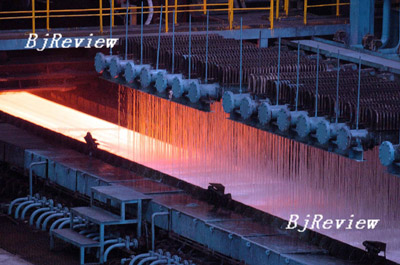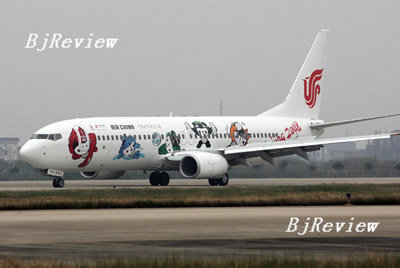|

State-owned enterprises (SOEs) directly affiliated with the Central Government have new goals of reform: to control the ordnance, electric power, oil and petrochemicals, telecommunications, coal, aviation and shipping industries.
The state has deemed these sectors crucial to China's national security and economic vitality.
On December 18, 2006, the State Council's State-owned Assets Supervision and Administration Commission (SASAC) for the first time declared that the state should have absolute control over the above-mentioned seven sectors. Furthermore, by 2010, the number of central SOEs should be reduced to 80-100 from the current 161 through mergers, and among them, 30-50 internationally competitive conglomerates should emerge. Those SOEs having no hope of eliminating losses should exit the market by 2008.
SOE reform has always been an important matter in China's economy. In 1994, SOEs began joint stock reform to adapt to the development of the market economy. However, when publicly listed SOEs issued stock, their shares were split into tradable shares and non-tradable ones, which were held by the state and legal persons and temporarily suspended from being traded in the stock market.
Such a split share structure caused great inconvenience to their development and market-oriented operation. In 2004, SOEs had to seek reform, allowing all shares to be traded.
According to SASAC's statistics, among the 190 listed firms held by central SOEs, 179 had either begun or completed their transformation into shareholding businesses by November 30, 2006.
It's obvious that central SOEs' share reform has drawn near to a close. At this time, the SASAC set out new goals for the reform of central SOEs, and its aim is far from making central SOEs just larger in size or more competitive.
Controlling economic lifelines
According to Li Rongrong, Minister in charge of the SASAC, central SOEs are now mainly distributed in three fields:
- Key sectors, including the above-mentioned seven industries. More than 40 of the 161 central SOEs are engaged in these sectors, with their total assets accounting for 75 percent of all central SOEs, and their profits, 79 percent.
- Pillar industrial sectors, including equipment manufacturing, automobiles, electronic information, construction, iron and steel, non-ferrous metals, chemicals, design, and science and technology. They include about 70 central SOEs with total assets and profits amounting to 17 percent and 15 percent of the total of central SOEs, respectively.
- Other sectors, including trade and logistics, investment, medicine, building materials, agriculture and geological prospecting.
"State capital must play a leading role in those key sectors, which are the vital arteries of the national economy and essential to national security," said Li.
Li continued that the state should solely own, or hold a majority share in, central SOEs engaged in the electric power, oil and petrochemicals, telecommunications and ordnance industries. However, central SOEs in the downstream petrochemical sector and in value-added telecom services can be allowed to absorb private or foreign capital.
In addition, central SOEs should become heavyweights in sectors like machine-building, automobiles, electronic information, construction, iron and steel and non-ferrous metals.
To realize state control of key sectors, the SASAC also put forth 10 measures to promote the restructuring of SOEs, including encouraging public listing of solidly performing SOEs and introducing overseas strategic investors.
In the last two years, as China has absorbed more and more foreign investment, some sectors have been controlled by foreign capital, arousing worries about national economic security.
But the above-mentioned seven key sectors do not cover all sectors involved in national security and economic vitality. Such sectors also include finance, railways and postal services. But when the SASAC was founded in 2003, it was designed to supervise only state-owned industrial enterprises.
Consolidating power
 Now that the new guidelines have been put forth, a new round of large-scale adjustment and restructuring will be conducted among central SOEs. Now that the new guidelines have been put forth, a new round of large-scale adjustment and restructuring will be conducted among central SOEs.
Since SASAC's founding in 2003, the number of central SOEs under its supervision has been reduced from 196 to 161, with those having similar core businesses being merged. Among the present 161, the core businesses of 137 have been decided upon.
But, according to the SASAC, the number will be further curtailed, with 80-100 central SOEs left by 2010. This means at least one-third will be eliminated.
As for the 161 central SOEs, a major problem is that a certain number of them are not engaged in important or key sectors, and they are small with little strength. Some even perform badly. Meanwhile, the number of central SOEs under SASAC's supervision is so large that SASAC's human resources can't be concentrated on key SOEs or key issues. "It's necessary to strengthen the adjustment and restructuring of central SOEs," said Li.
With regard to the proper number of central SOEs, "to cut the number to 80-100 is practical, according to our analysis," said Wang Zhigang, Director of the Company Reform and Development Studies at a think-tank affiliated with the SASAC. In 2005, the top 80 central SOEs in terms of state-owned assets accounted for 99 percent, 98 percent and 92 percent of total central SOEs' profits, state-owned assets and sales revenue, respectively.
"In the meantime, normally the number of central SOEs in important or key sectors won't exceed 100," said Wang.
Liu Cheng, professor from the School of Economics and Management, University of Science and Technology Beijing, said cutting the number of SOEs can mainly be realized via restructuring or mergers, which can happen not only among SOEs, but also between SOEs and non-state enterprises. But this should be done openly and fairly with sufficient supervision to avoid underhanded manipulation.
Liu's view was echoed by Gao Minghua, professor from the School of Economics and Business Administration of Beijing Normal University. Gao said restructuring and mergers should be market-oriented. "If SOEs are restructured or merged under government instructions like in the past, they cannot adapt to the market or reach the goal of being mutually complementary, which is neither good to their development, nor to keeping or increasing the value of state-owned assets," said Gao.
Profit driven
With China's market fully opened to the outside world, competition has become much fiercer. The government should adjust the distribution and structure of the whole state-owned economy so that central SOEs can gain control over the seven key sectors. Great achievements have been made in this area, according to Li.
Li said that from the beginning of 2003 when the SASAC was founded to the end of 2005, the number of state-owned and state-holding enterprises decreased from 159,000 to 127,000, down by 20 percent, while their aggregate state-owned assets, sales revenue, profits and tax payment all soared during the period.
During this period, total assets and sales revenue of central SOEs increased more than 1 trillion yuan each year, with profits and tax payment both rising by more than 100 billion yuan annually.
In 2005, the number of state-owned and state-holding industrial enterprises only accounted for 11 percent of the country's total industrial enterprises, but their sales revenue, profits and tax payment accounted for 35 percent, 45 percent and 57 percent of the respective total.
From 2002 to 2006, among the world's top 500 enterprises, the number of domestic enterprises grew from 11 to 19, 13 of which were central SOEs.
Obviously, under this circumstance, the SASAC can set out new guidelines for the reform of central SOEs.
Li pointed out that efforts should be made to deepen SOE reform, improve state-owned assets supervision and administration, and properly solve some long-standing problems to ensure the achievement of the set goals.
To deepen SOE reform, joint stock reform of central SOEs should speed up and a complete corporate governance structure should also be established.
Restructuring, absorbing strategic investors and getting listed on both domestic and overseas stock markets are the main ways for SOEs to diversify their ownership. In the first half of 2006, central SOEs raised HK$6.77 billion on the Hong Kong stock market and 440 million yuan in the domestic stock market.
To improve corporate governance, the most important thing is to introduce outside board directors into wholly state-owned companies and set up or complete the boards of directors. So far, 19 wholly state-owned companies have tried setting up boards of directors, with 64 outside members. The SASAC requires all wholly state-owned companies to set up standard boards of directors, except those companies with limited decision-making rights.
|
Background of Central SOE Reform
Central SOE reform began in 1979. Before 1979, the government was responsible for the management and operation of all state enterprises, and their profits were also owned by the government. At that time, state enterprises were called state-run enterprises.
1979-84: State-run enterprises made the first step of reform. They began to have more decision-making rights for operation.
1985-93: Ownership and management of state-run enterprises were separated. State-run enterprises thus became state-owned enterprises.
1994: SOE reform began progressing toward the goal of "establishing the modern corporate system." Central SOEs became the key object of reform. The Corporate Law was formally implemented in 1994, marking a new phase for SOE reform.
1999: The CPC Central Committee released a document on several important issues related to SOE development and reform, indicating that SOE reform entered another phase of "strategic adjustment in the distribution of the state economy."
2003: The SASAC was founded, supervising 196 central SOEs on behalf of the Central Government. Thus, adjustment in distribution and structure of the state economy began to be subject to unified planning and market-oriented operation by the SASAC. Moreover, the SASAC as a representative of the investors of all SOEs, can, to some extent, facilitate the improvement of large SOEs' corporate governance.
December 2006: The SASAC, for the first time, clearly specified industrial sectors in which the state economy should have absolute control, be influential or play a leading role. According to SASAC's plan, by 2008, non-performing SOEs should exit the market, and by 2010, the number of central SOEs should total 80-100, among which, 30-50 should be internationally competitive. |
|
